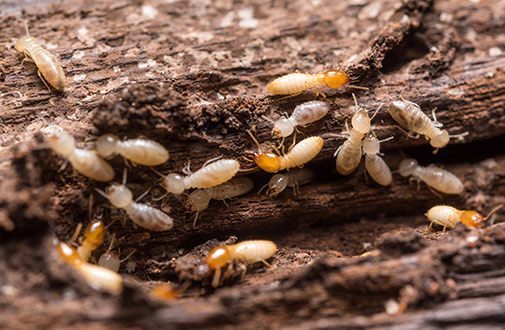What Exactly Are Termites
Seitz Bros. services northeast and central Pennsylvania as well as western New Jersey. In this region, the termite you’re most likely to encounter is the subterranean termite. Unfortunately, this is also the most destructive species.
Appearance
Subterranean termites are about 1/8” long with six legs, antennae, and are creamy-white with dark brown or black areas, depending on their role in the colony. Like ants, termites have different “jobs” to play in their colony:
- Swarmers, or alates, are dark brown or black, about ¼ to ½ inch in size, and have two pairs of wings that are close together
- Workers are cream-colored, about ¼ inch in size, without wings
- Soldiers are also cream-colored, have no wings, large jaws, and are known to defend the termite colony
Signs of a Termite Infestation
Damage to Wood
Termites eat wood fibers, so if you notice damage to wooden structures in your home, furniture, or walls, it could be a sign that termites are present.
Termite Tubes
Subterranean termites use mud to create protective tunnels through which they can travel safely to and from different parts of the colony. You may notice these protruding mud tunnels sticking out from the corners or walls of your home. At first glance, it might look like damp sand. If you spot a termite tube, it’s imperative to call pest control immediately because by the time tubes are visible, the infestation is well underway.
Hollow Sounds
Since termites devour wood from the inside out, you can hear a change in how sound travels through surfaces. Gently tap on the wall, door, or other structure you believe infested and see if it sounds hollow. If the damage is extensive, you may even notice that the wood crumbles easily with just a bit of pressure applied.
Unexplained Noises
As unsettling as it may be, termites produce a clicking sound as they eat wood. Place your ear against the area where you think they’re active and see if you can hear a clicking or scratching sound coming from the walls.
Discard Wings
Remember the swarmers that we spoke about earlier? Termites with this role will discard their wings once they’re done scouting. As such, you might find insect wings along the floor, but they won’t be attached to a bug.
Frass
This is the official term for termite feces. It looks like a pile of sawdust or birdseed and is generally very close to the kick-out hole – an opening in the wall or area of termite activity where workers remove fecal matter and toss it out of the hole. If you find a pile of termite frass, it’s actually best to let it sit until your pest control technician arrives. Because these piles are so close to kick-out holes, this will make it easier for the technician to reach the main part of the colony, which means a quicker extermination.
How To Prevent Termites
- Stack firewood away from your home. This will prevent many other insects as well!
- Use termite-proof paint or stains on exterior wooden structures like fences.
- Trim shrubs or trees, so they aren’t touching your home.
- Address leaks, keep gutters clear, and in general reduce excess moisture from reaching your foundation.
- Remove termite food sources like dead or rotting wood, stumps, newspapers, cardboard, and other paper products.
- Call the experts at Seitz Bros. We will not only address the infestation but we’ll also help you identify problem areas on your property that could attract termites in the future.
Tired of Termites? Seitz Bros. Can Help!
Whether you suspect you’ve got termites or know for certain you do, the experts at Seitz Bros. can help rid your property of these destructive bugs. Our termite control program services, customers, across northeast and central Pennsylvania, as well as western New Jersey. Call 570-225-0034 or click here to get a free quote today!Check out our blog page for more tips on keeping your property pest-free! https://www.seitzbrothers.com/blog/

